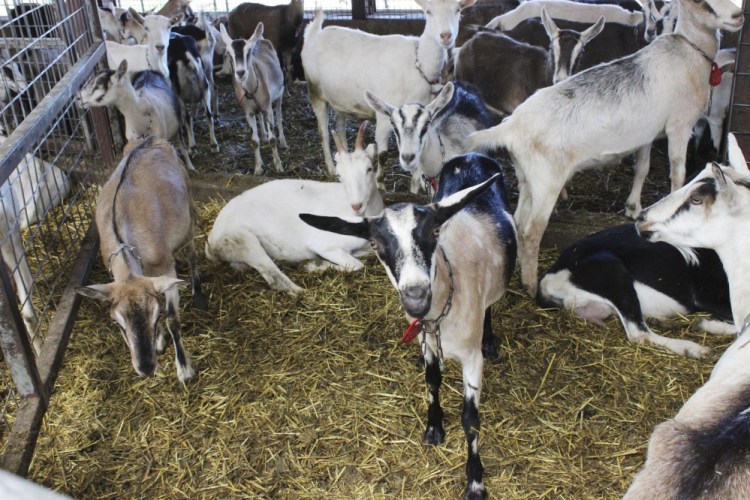PIPE, Wis. — Wisconsin has long been as one of the nation’s leaders in cow dairies, farm after pastoral farm tucked into the state’s rolling hills. It’s earning another milk laurel in the face of increasing demand for goat cheese and milk: the most dairy goats in the U.S. That distinction will only stand to increase when two of the largest goat dairies in the world soon begin operating in northeast Wisconsin.
It’s something Larry and Clara Hedrich didn’t expect when they started raising dairy goats in the 1970s as a hobby. They now milk 800 dairy goats, make award-winning cheese from cow, sheep and goat milk and boast enough capacity to process triple what they currently do.
“We’re competing in our farm here in Pipe, Wisconsin, with the world,” Larry Hedrich said.

Dairy goats feed at LaClare Farms near Pipe, Wis. Larry and Clara Hedrich started raising dairy goats in the 1970s. They now milk about 800 goats and make award-winning cheese sought by chefs, immigrants and other consumers.
The growth in Wisconsin – as well as California, which is No. 2 in goat- and sheep-milk sales – is due to both existing infrastructure and growing appreciation for goat milk in the U.S. Chefs are using it more frequently, consumers are seeking out its unique taste and growing immigrant populations from places like East Africa and Latin America are looking for the familiar products, according to Norm Monsen, dairy economic development consultant at the Wisconsin Department of Agriculture, Trade and Consumer Protection.
But there’s a lack of research and goat-specific products, like medicine or feed, which can be problematic for farmers who are turning to the emerging market.
Goat milk in the U.S. is used mostly for cheese, retail sales of which reached $142 million this year, up 8 percent from $131 million in 2015, according to the Wisconsin Milk Marketing Board. The quality of Wisconsin’s goat milk products is on the rise, too, occasionally winning awards over cheese made from cow’s milk.
“There’s been nowhere near the amount of milk produced as is needed,” Hedrich said, noting that some cheesemakers ship in frozen curds from Europe and import raw milk from Canada to fill the gap. “Our plant has been running starved for milk since we opened.”
Wisconsin farmers have been trying to catch up. There are 267 licensed goat farms – more than double from 2004, when there were 126, state agriculture officials said. And the dairy goat herd has increased 70 percent since 2002, from 25,900 to 44,000. Wisconsin had almost $12.9 million in sales of goat and sheep milk in 2012, the most recent statistic available.

Larry Hedrich holds cheese produced at LaClare Farms. “We’re competing in our farm here in Pipe, Wisconsin, with the world,” he said. U.S. retail sales of goat cheese reached $142 million this year, up 8 percent from 2015.
California’s 39,000 goats trail only Wisconsin, and it had the second-highest sales of sheep and goat milk in 2012, at $12 million, according to the U.S. Department of Agriculture.
“The market is growing by leaps and bounds,” said Vicki Tonn, president of the Wisconsin Dairy Goat Association. “I can’t see it reversing. I can’t see there being a surplus.”
But whereas cow dairies have extensive research and lots of university experts to offer advice, there’s not a single person at the University of Wisconsin who’s dedicated to dairy goats. The lack of research can lead to greater obstacles for farmers when their goats fall ill or they want to expand or try a new practice. It also means goat dairies largely face the same regulations as cow dairies, even though they’re different animals.
“I think it’s really a shame,” said Dave Thomas, an animal sciences professor at the University of Wisconsin-Madison who focuses on dairy sheep. “The dairy goat industry is large enough in the state to deserve some research and outreach expertise, but there is none.”
Some hope the advent of the two large dairies in northeastern Wisconsin will change that by encouraging more research and providing a model for others to follow.
Send questions/comments to the editors.


